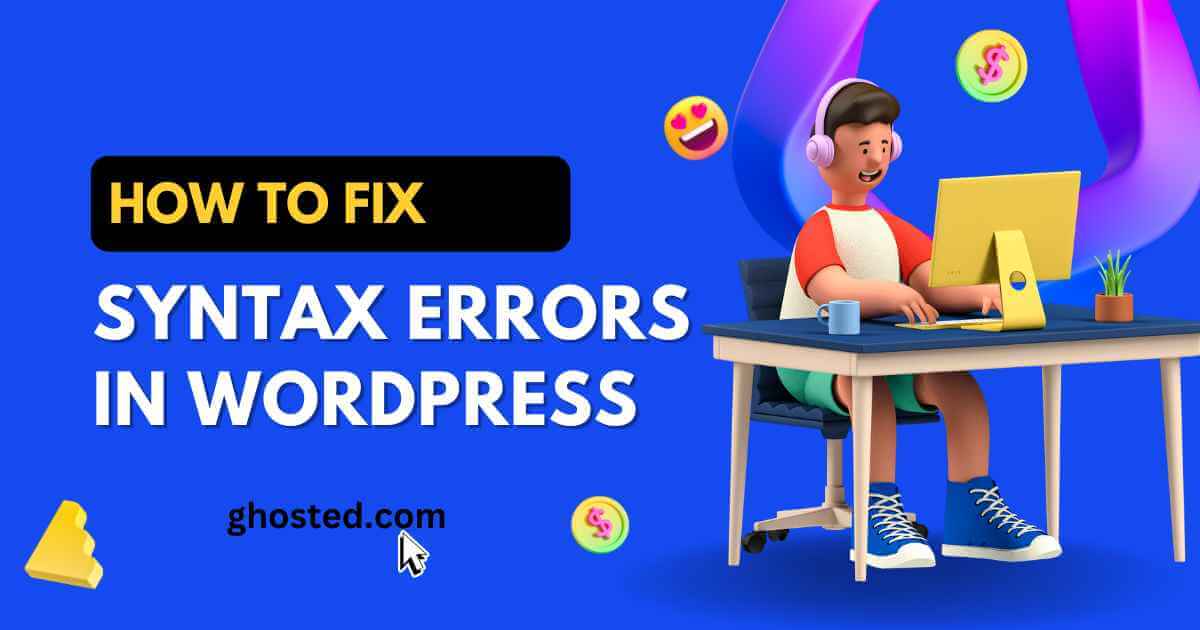Ever stumbled upon a syntax error on your WordPress site and felt like pulling your hair out? You’re not alone. Syntax errors can make your website inaccessible, but thankfully, they’re fixable with the right guidance. This post dives into the nitty-gritty of diagnosing and correcting syntax errors in WordPress, ensuring you get back on track without losing your cool. Whether you accidentally tweaked the code or updated a theme that went awry, we’ve got the solutions to bring your site back from the brink.
Table of Contents
ToggleBacking Up WordPress Files
Regular Backups
Regular backups are your safety net. They prevent data loss during syntax error fixes in WordPress. Without them, you risk losing all your hard work.
You should set a schedule for these backups. Weekly or monthly options are common. This ensures you always have a recent copy of your website.
Automated Plugins
Plugins simplify the backup process on WordPress sites. They automate the task, saving time and effort.
Popular plugins include UpdraftPlus and BackupBuddy. These tools offer scheduled backups and easy restoration options.
Using them means less worry about manual errors or forgetting to back up.
Manual Methods
For those who prefer control, manual backup methods exist. They use cPanel or FTP access to download website files directly.
To start, log into cPanel and find the File Manager. Here, you can compress and download your entire WordPress directory.
FTP requires an application like FileZilla. Connect it to your server using provided credentials. Then manually select and download the needed files.
This method suits advanced users comfortable with web hosting environments.
Identifying Common Syntax Errors
Error Manifestation
Syntax errors in WordPress often lead to the white screen of death or specific error messages. These signs indicate a problem in the site’s code.
When a syntax error occurs, users might see nothing but a blank page. This is known as the white screen of death. At times, WordPress will pinpoint the problem through an error message. These messages are crucial for troubleshooting.
Common Causes
Several mistakes can lead to syntax errors. Missing semicolons and braces top this list.
A missing semicolon (;) at the end of a line is a frequent oversight that disrupts code execution. Similarly, forgetting closing braces ({}) creates confusion in defining code blocks. Incorrect function usage also triggers these errors, especially for beginners tweaking their site’s PHP files.
Reading Messages
Understanding error messages is key to fixing syntax issues quickly.
Error messages usually include the file name and line number where the mistake occurred. This information acts as a guide to pinpointing and correcting the fault directly in your editor.
Remember, backing up WordPress files before making changes prevents data loss from syntax corrections gone wrong.
Editing PHP Files Safely
Child Theme
Creating a child theme is essential for safe modifications to your WordPress theme files. This method protects your site when updating the parent theme. It ensures that customizations are not lost.
A child theme involves creating a separate folder in your WordPress themes directory. You then copy the PHP file you wish to modify from the parent theme into this folder. Changes made here override the parent theme’s files, keeping your edits secure.
Dashboard Editor
Accessing and editing PHP files can also be done through the WordPress dashboard editor. However, proceed with caution. A single mistake can break your site.
Before making changes, always back up your website. Navigate to Appearance > Theme Editor in the WordPress dashboard. Select the correct file from the right-hand side list and make your edits carefully. Remember, understanding code editors and syntax is crucial here.
Local Environment
We strongly recommend using a local development environment for testing changes before going live. Tools like XAMPP or MAMP create a safe space on your computer where you can edit and experiment without risk.
This approach allows you to catch and fix any syntax errors identified in previous steps without affecting your live site’s functionality or user experience.
Using SFTP for Error Resolution
SFTP Setup
To start, secure SFTP access with your hosting account. This process varies but generally involves logging into your web host and navigating to the SFTP section. Here, you’ll create or find existing credentials: a username, password, and sometimes a port number.
Once set up, download an SFTP client like FileZilla or WinSCP. Launch it and enter your credentials to connect to your server.
Locating Files
With access secured, locate the erroneous file causing the syntax error. Remember from “Editing PHP Files Safely,” we’re likely dealing with a PHP file recently edited.
Navigate through your website’s directory structure in the SFTP client. Look for folders like wp-content if you suspect a theme or plugin is at fault.
Making Edits
Upon finding the problematic file, right-click and choose Edit or View/Edit depending on your client. This action opens the file in a text editor.
Proceed with caution here. Make necessary corrections to fix syntax errors identified earlier. If unsure about what changes to make, consider reverting recent edits by comparing this version of the file with an older one if available.
Remember: always save backups before making any changes directly on live sites to prevent further issues.
Enabling Debugging Tools
WP_DEBUG
To pinpoint syntax errors in WordPress, enabling WP_DEBUG is crucial. This tool, found within the wp-config.php file, provides detailed error messages. To activate it, access your server via SFTP as previously discussed. Open the wp-config.php file and locate the line that reads define('WP_DEBUG', false);. Change false to true to turn on debugging mode.
Once activated, revisit your site in a browser. You’ll see error messages that guide you to the problem’s source. These messages often include specifics like the faulty plugin or theme, making fixes more straightforward.
Additional Constants
For deeper debugging, consider two more constants: WP_DEBUG_LOG and WP_DEBUG_DISPLAY. Adding define('WP_DEBUG_LOG', true); creates a log file in your site’s directory containing all errors—useful for tracking issues over time without cluttering your browser window.
Conversely, setting define('WP_DEBUG_DISPLAY', false); ensures error messages don’t appear on your live site. It keeps visitors from seeing unsightly warnings while you troubleshoot behind the scenes.
Security Reminder
After resolving syntax errors, remember to disable these debugging tools by resetting their values to false or removing them entirely from wp-config.php. Keeping debug mode active can expose sensitive information about your website structure and vulnerabilities—a risk for security breaches.
Addressing Plugin and Theme Issues
Plugin Deactivation
Deactivating all plugins is a crucial step. It helps isolate the problem. You can do this via FTP/SFTP or phpMyAdmin. First, access your site’s files through an FTP client. Navigate to the “wp-content” folder. Locate the “plugins” directory.
Rename it to something like “plugins_old”. This action deactivates all plugins at once. Check your site now. If it works, one of the plugins was causing the syntax error.
Theme Switch
Sometimes, themes cause issues too. Switching to a default WordPress theme can clarify this. In your dashboard, go to Appearance > Themes.
Activate a default theme like Twenty Twenty-One. If your site functions well after this switch, your theme was likely the issue.
Updates Importance
Keeping themes and plugins updated is vital for compatibility and security reasons. Outdated versions often lead to conflicts resulting in syntax errors.
Regularly check for updates in your dashboard under Plugins and Themes sections respectively. It ensures that everything runs smoothly on your website without any compatibility issues.
Utilizing PHP Code Checkers
Online Validators
Online PHP code validators are essential tools for quickly identifying syntax errors in custom code snippets. These platforms allow developers to paste their code and check for mistakes without running the script on a live site. They provide immediate feedback, highlighting the exact location of errors.
Many online validators offer suggestions for fixing identified issues. This feature is particularly useful when dealing with complex WordPress themes or plugins that might have caused a syntax error after an update or modification.
Desktop Applications
For a more comprehensive analysis, desktop applications serve as robust solutions. They not only check syntax but also help in understanding the structure and logic behind the code. Before deployment, using these applications ensures that all custom code is free from errors.
Desktop tools often come with advanced features like debugging and performance analysis. This makes them invaluable for serious development work where precision is crucial.
Development Integration
Integrating code checking tools directly into development environments can significantly enhance productivity and prevent errors from occurring in the first place. Many Integrated Development Environments (IDEs) support plugins or extensions that automatically check your code as you write it.
This integration acts as an ongoing guardrail against potential syntax errors, ensuring that any mistake is caught early in the development process before it affects your WordPress site’s functionality.
Seeking Professional Help
Time to Consult
Sometimes, the problem lies deep within the code or WordPress setup. It might look daunting. The good news is, help is available. Knowing when to seek professional assistance can save you time and frustration.
If you’ve tried utilizing PHP code checkers and the issue persists, it’s a clear sign. Especially if your site displays a blank page or specific content fails to load correctly. These symptoms often indicate a syntax error that requires expert attention.
Finding Support
There are several ways to find reliable help for your WordPress troubles.
Firstly, official WordPress forums offer a wealth of information and community support. Users share similar problems and solutions here. Secondly, reputable support forums outside of WordPress can also be valuable resources. They often have experienced developers willing to assist. Lastly, hiring a developer might be necessary for more complex issues. Look for someone with experience in fixing syntax errors in WordPress specifically.
Clear Communication
Effective communication with your chosen expert is crucial.
They need detailed information about what was recently changed on your site and any error messages received. This helps them understand the cause of the problem faster. Explain everything clearly but concisely. Remember, they’re there to assist you in getting back on track as soon as possible.
Final Remarks
Fixing syntax errors in WordPress might seem daunting, but armed with the right strategies—from backing up files and editing PHP safely to utilizing code checkers and seeking professional help—you’re well-equipped to tackle them head-on. Each step you’ve learned is designed to navigate the complexities of syntax errors efficiently, ensuring your website remains robust and functional. Remember, the key is not just in fixing the errors but in understanding how they arise and preventing them in the future.
Now that you’ve got the know-how, it’s time to dive in and apply these solutions. Don’t let a syntax error throw a wrench in your site’s performance. Roll up your sleeves, use these tips, and keep your WordPress site running smoothly. Got questions or need further assistance? Reach out for professional help and keep your WordPress journey on track.
Frequently Asked Questions
How do I fix a syntax error in WordPress?
First, identify the common syntax errors through your site’s error messages. Edit PHP files using a text editor and correct the code mistakes carefully. Use SFTP to access and modify your files securely if you can’t access the WordPress dashboard.
What should I do before trying to fix a WordPress syntax error?
Always back up your WordPress files and database. This ensures that you can restore your website to its previous state if anything goes wrong during the fixing process.
Can enabling debugging tools help with WordPress syntax errors?
Yes, enabling debugging tools in WordPress can help by providing detailed error messages. These messages make it easier to locate and understand the source of syntax errors for quicker resolution.
How can plugins or themes cause syntax errors in WordPress?
Plugins or themes may introduce syntax errors if they’re poorly coded or incompatible with your version of WordPress. Deactivate all plugins and switch to a default theme temporarily to see if this resolves the issue.
Is it safe to edit PHP files directly for fixing syntax errors?
Editing PHP files directly is safe as long as you have a backup and use a proper text editor. Ensure you understand the changes you’re making; otherwise, consider seeking professional help.
How can I use PHP code checkers to resolve syntax errors in WordPress?
PHP code checkers analyze your scripts for common issues and highlight where errors occur, making it easier for you to pinpoint and correct them without extensive coding knowledge.
When should I seek professional help for fixing syntax errors in WordPress?
If after attempting the above steps, you’re unable to resolve the issue or are uncomfortable editing PHP files yourself, it’s wise to seek professional help from experienced developers familiar with WordPress troubleshooting.




